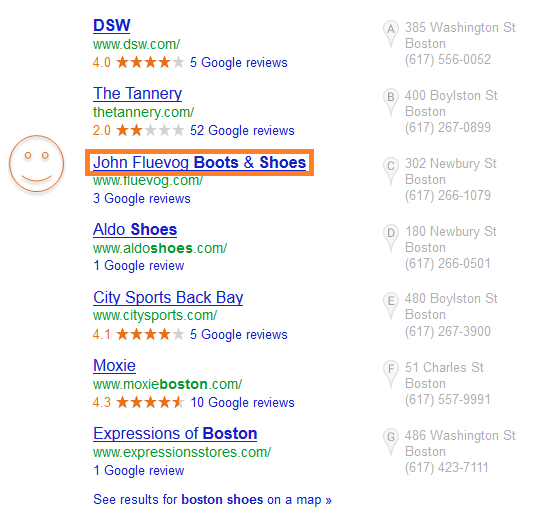1,083,219 People Per Month and Counting: My New Favorite SEO Strategy
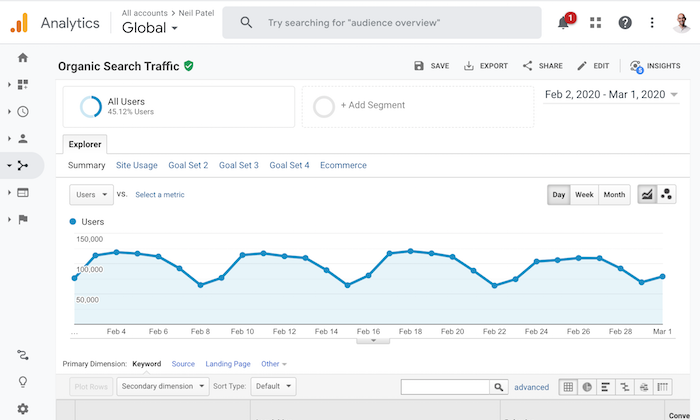
Podcasting.
You’ve heard about it before and I bet you’ve even listened to a handful of podcasts. But you probably haven’t created one yet.
Just think of it this way…
There are over 1 billion blogs and roughly 7 billion people
in this world. That’s 1 blog for every 7 people…
On the other hand, there are roughly 700,000 podcasts. That means there is only 1 podcast for every 10,000 people or so.
Podcasting is 1,428 times less competitive than blogging.
So, should you waste your time on podcasting?
Well, let me ask you this… do you want a new way to get more organic traffic from Google?
I’m guessing you said yes. But before I teach you how to do that, let me first break down some podcasting stats for you, in case you aren’t convinced yet.
Is podcasting even worth it?
From a marketing and monetization standpoint, podcasting isn’t too bad.
I have a podcast called Marketing School that I do with my buddy Eric Siu. We haven’t done much to market it and over time it’s grown naturally.
Here are the stats for the last month.
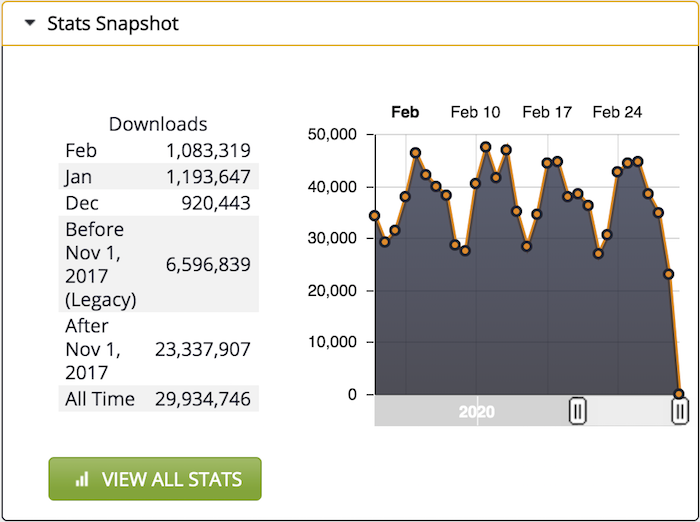
We got 1,083,219 downloads or “listens” last month. To give you an idea of what that is worth, Dream Host paid us $60,000 for an ad spot…
They’ve also been paying us for a while, technically we have a 1-year contract worth $720,000.
Now on top of the ad money, Eric and I both have gotten clients from our podcast. It’s tough to say how much revenue we’ve made from the podcast outside of advertising, but it is easy to say somewhere in the 7-figure range.
Keep in mind, when I make money through ads or generate revenue for my ad agency, there are costs so by no means does that revenue mean profit.
Sadly, my expenses are really high, but I’ll save that for a
different post.
But here is the cool thing: Eric and I only spend 3 hours a month to record podcast episodes for the entire month. So, the financial return for how much time we are spending is high.
And if that doesn’t convince you that you need to get into podcasting, here are some other stats that may:
- 32% of Americans listen to a podcast at least
once a month. - 54% of listeners think about buying products advertised
in podcasts. - Businesses spent $497 million on podcast ads in
2018 (probably much larger now). - 51%
of monthly active podcast listeners have an annual household income of at
least $75,000.
If you haven’t created a podcast, this guide will
teach you how. And this
one will teach you how to get your first 10,000 downloads.
Alright, and now for the interesting part…
How to get more SEO traffic through podcasting
Back in 2019, Google saw how podcasts were growing at a rapid pace and they didn’t want to miss out.
They wanted people to continually use Google, even when it came to learning information that is given over audio format. So they decided to make a change to their search engine and algorithm and started to index podcasts and rank them.
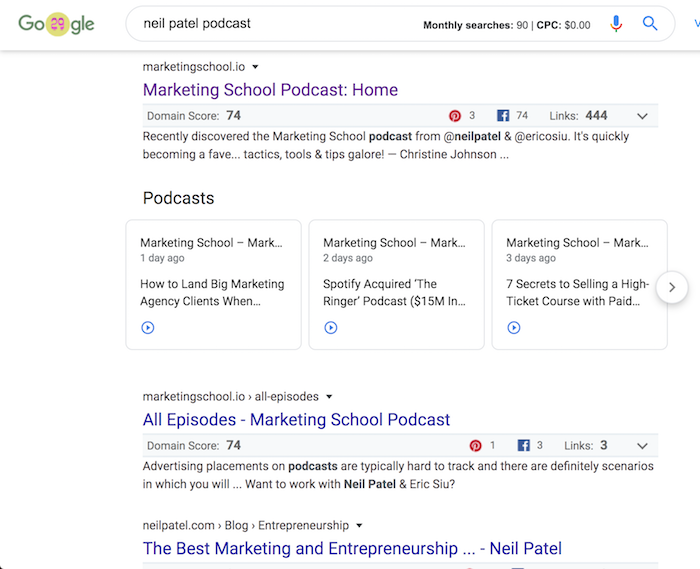
And depending on what you search for and the more specific you get, you’ll even notice that Google is pulling out details from specific episodes. This clearly shows that they are able to transcribe the audio automatically.
This shouldn’t be too much of a shocker as they’ve already had this technology for years. They use it on YouTube to figure out what a video is really about.
But here is the thing, just recording a podcast and putting
it out there isn’t going to get you a ton of search traffic.
So how do you get more SEO traffic to your podcast?
It starts with topics
Podcasting is a lot like blogging.
If you create a blog post on any random topic that no one
cares to read about, then you aren’t going to generate much traffic… whether it
is from social or search.
The same goes for podcasting. If you have an episode on a random topic that no one cares to listen to, then you won’t get many downloads (or listens) and very little SEO traffic as well.
Just look at the stats for a few of our episodes.
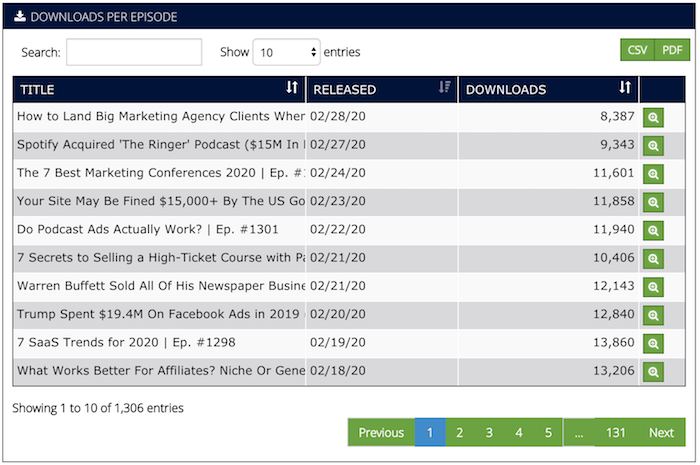
Look at the screenshot above, you’ll see some do better than
others.
For example, the episode on “7 Secrets to Selling High Ticket Items” didn’t do as well as “The 7 Best Marketing Conferences 2020” or even “How to Drive More Paid Signups In Your Funnel.”
You won’t always be able to produce a hit for every podcast
you release, but there is a simple strategy you can use to increase your success
rate.
First, go to Ubersuggest
and type in a keyword or phrase related to what your podcast is about.
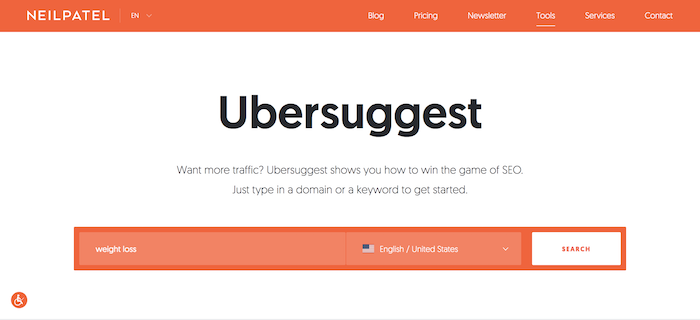
Once you type in your keyword or phrase, hit search.
You’ll land on a screen that looks something like this:
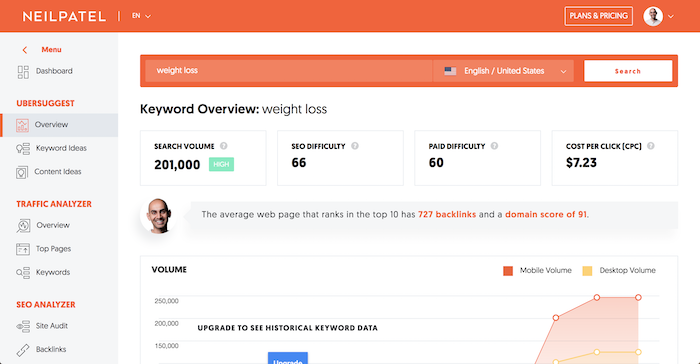
Then in the left-hand navigation, click on the “Content Ideas” option.
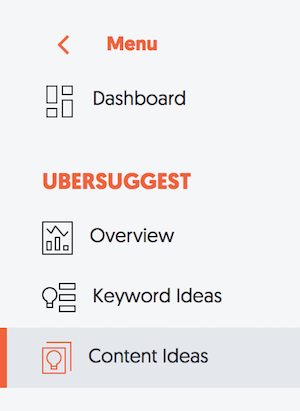
From there, you’ll see a list of popular topics on the subject you are researching.
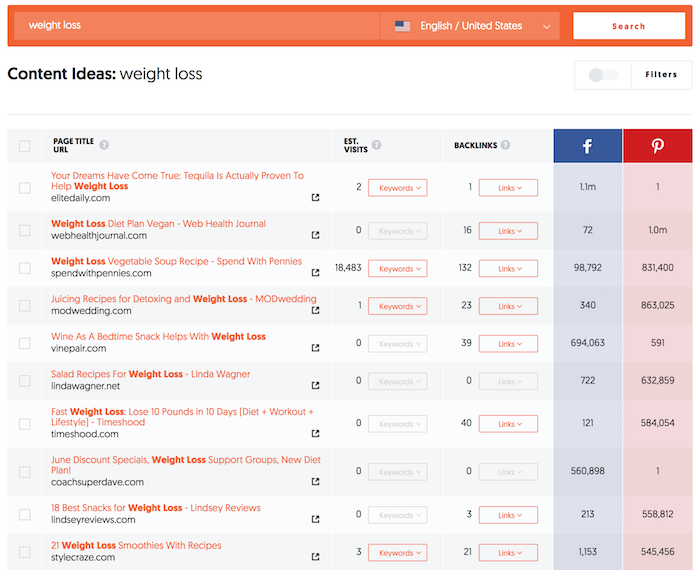
This report breaks down popular blog posts based on social shares, SEO traffic, and backlinks.
Typically, if a blog post has all 3, that means people like the topic. Even if it has only 2 out of the 3, it shows that people are interested in the topic.
What we’ve found is that if a topic has done well as a blog post, it usually does well as a podcast episode.
See with the web, there are so many blogs, most topics have been beaten to death. But with podcasting, it is the opposite. Because there are very few podcasts, most topics haven’t been covered.
And if you take those beaten-to-death blog topics and turn them into podcast episodes, it is considered new, fresh content that people want to hear. And they tend to do really well.
Now you have to dive into keywords
Hopefully, you are still on the content ideas report and you’ve found some ideas to go after.
If not, just scroll down to the bottom of the Content Ideas report and keep clicking next… even if only a few numbers show, don’t worry, there are millions of results and as you go to the next page, more pages will show up.

Once you find a topic, I want you to click the “Keywords” button under the “Estimated Visits” column.
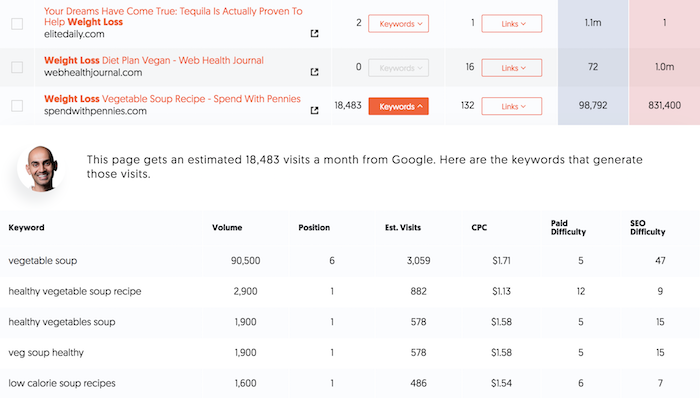
This will give you more specific keywords to mention and so you can go even more in-depth during your podcast episode.
Remember that Google is able to decipher your audio and knows what topics and keywords you are covering.
So, when you mention a keyword within your podcast, your podcast episode is more likely to rank for that keyword or phrase.
But there are a few things I’ve learned through this whole process:
- You don’t have to keyword stuff – you don’t have to mention a keyword 100 times or anything crazy if you want to rank well organically. Mention it whenever it is natural.
- Episodes titles that contain popular keywords tend to do better – do your keyword research and include the right keywords within your title (I’ll show you how in a bit).
- Episode titles that contain questions do well – eventually, you’ll also see these episodes perform even better because when people ask questions in the future on smart assistants like Alexa and Google Home, you’ll eventually start to see them pull from podcasts.
So how do you find the right keywords and questions to
incorporate into your podcasts?
Head back to Ubersuggest and type in a keyword or phrase related to a podcast episode you want to create. This should be a bit easier now because you’ve already leveraged the Content Ideas report to come up with popular topics that people want to hear about. 😉
This time, I want you to click on the “Keyword Ideas” report in the left-hand navigation.
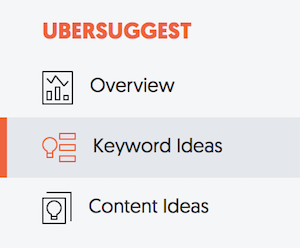
You’ll then see a list of suggestions that look something like this.
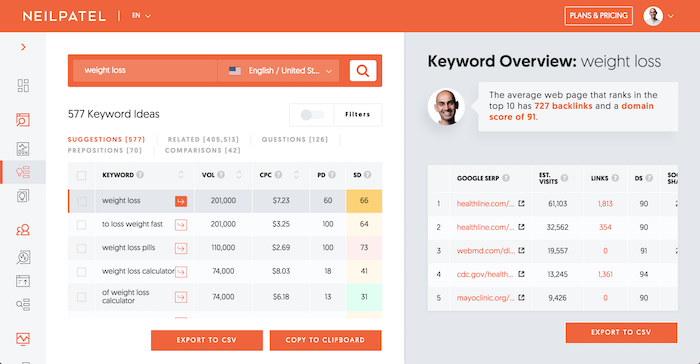
As you scroll down, you’ll continually see more and more keywords.
Don’t worry about the CPC data, but you will want to look at the SEO difficulty score as the easier the score the better chances you will have of ranking your podcast episode on Google. Also, look at search volume… the higher the number the better as that means more potential listens.
My recommendation for you is to target keywords and phrases that have an SEO difficulty of 40 or less.
Once you have a list of keywords, I want you to click on the “Related” navigational link on that report.
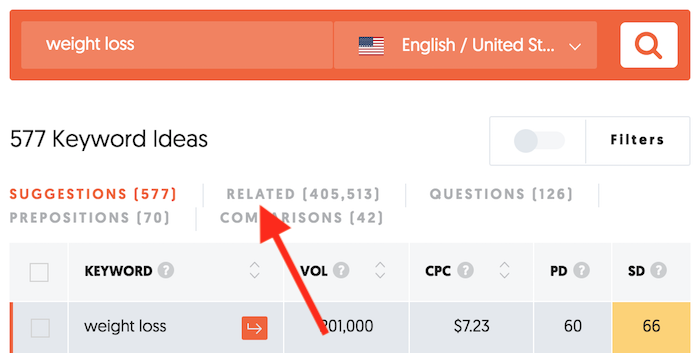
Now, you’ll see a much bigger keyword list.
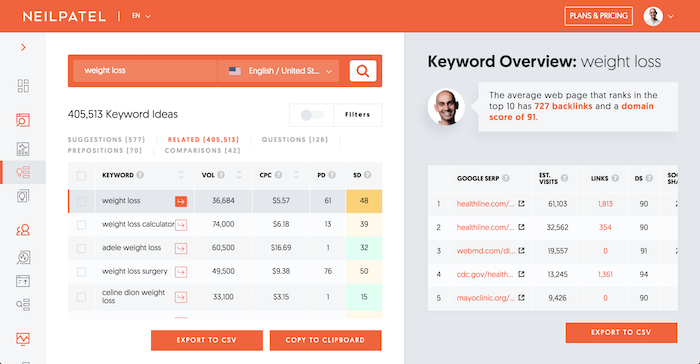
In this case, you’ll see 405,513 related keywords that you can target. Again, ignore the CPC data but target keywords with an SEO difficulty of 40 or less and the more popular the keyword the better.
Lastly, I want you to click on the “Questions” navigational link…
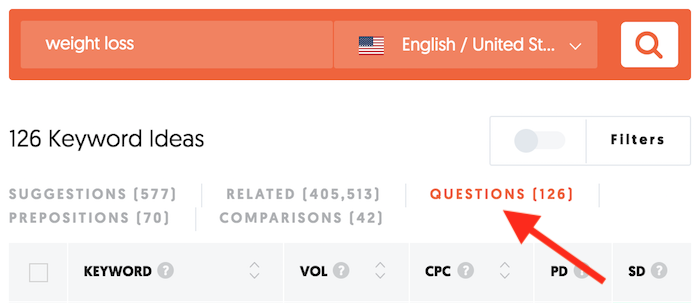
Then scroll through the list and you’ll see a list of
questions that you can target.
According to Comscore, over 50% of the searches are voice searches. A large portion of those are questions, so covering them within your podcast or even labeling your titles based on questions is a great way to get more traffic.
If you don’t think going after questions is a good strategy
to get more traffic, just look at Quora.
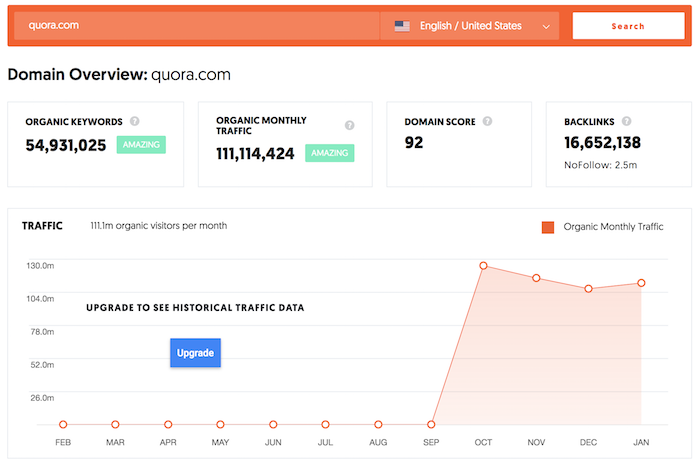
With roughly 111,114,424 estimated visits a month from Google, Quora is getting a lot of traffic by optimizing their site for question-related keywords.
Conclusion
Google
is the most popular site in the world. Whether you love SEO or hate it, you
have no choice but to leverage it.
One way to get more SEO traffic is to write tons of content and leverage content marketing. It’s a competitive approach and you should consider it.
But another solution that’s even easier is to create a podcast and rank it well on Google.
And ideally, you should be doing both.
Do you have a podcast? Have you tried ranking audio
content on Google?
The post 1,083,219 People Per Month and Counting: My New Favorite SEO Strategy appeared first on Neil Patel.





